There’s a reason—beyond sheer popularity—why so many full-line carmakers have led with crossovers as they ramp up their lineups for the electric era: Sporty midsize sedans like the Hyundai Ioniq 6 require more push and pull to look right while delivering the aerodynamic efficiency that’s so important for driving range.
To fit thick battery packs under the passenger floor means pushing up the roofline and compromising proportions to compensate, or settling for a cabin that feels more cramped. On the other hand, traditional three-box sedans are compromised in the wind tunnel; it’s why so many automakers have settled for the tall-tail “kammback” form instead, with a hatchback instead of a trunklid.
Put the two together and it’s daunting. With sedans no longer the core of the auto market, it’s less surprising why so few automakers have tackled an electric sedan.
But Hyundai has threaded the needle and ended up with something jaw-droppingly unique in the Ioniq 6. The Ioniq 6 simultaneously solves the aero issue and treads new design ground, making other sedans look antiquated.
Hyundai’s early tease of range results might be enough to convince skeptics. The Ioniq 6 will bear a WLTP range rating of up to 382 miles, according to the automaker. Based on how the Ioniq 5 crossover has fared in the EPA cycle, versus the more optimistic European WLTP, that will land it very close to the Model 3 Long Range’s 358 miles.
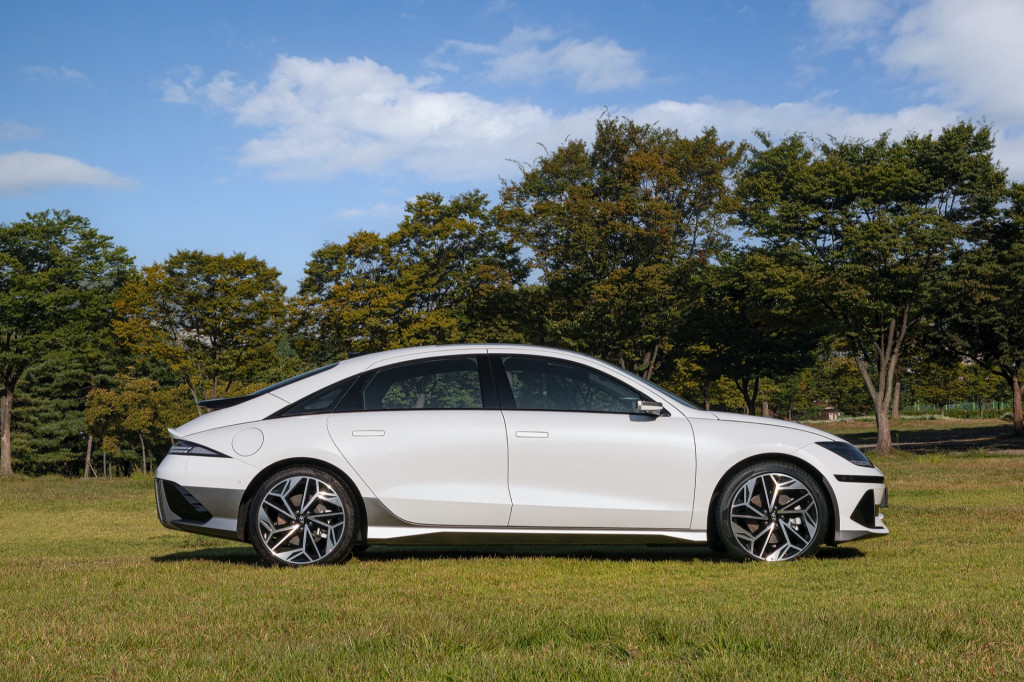
2023 Hyundai Ioniq 6
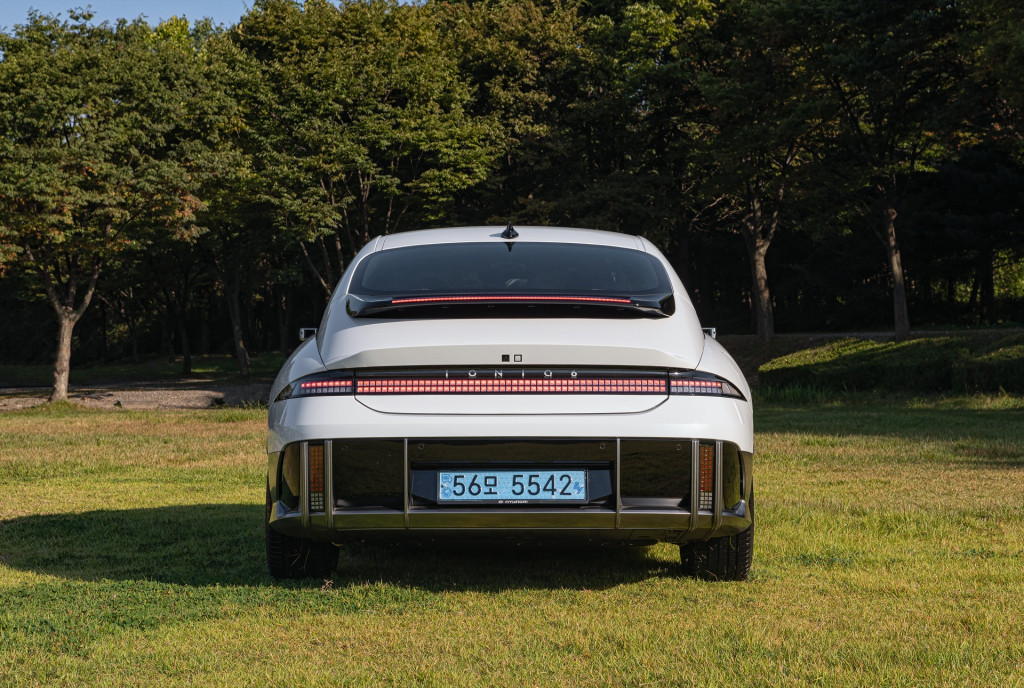
2023 Hyundai Ioniq 6
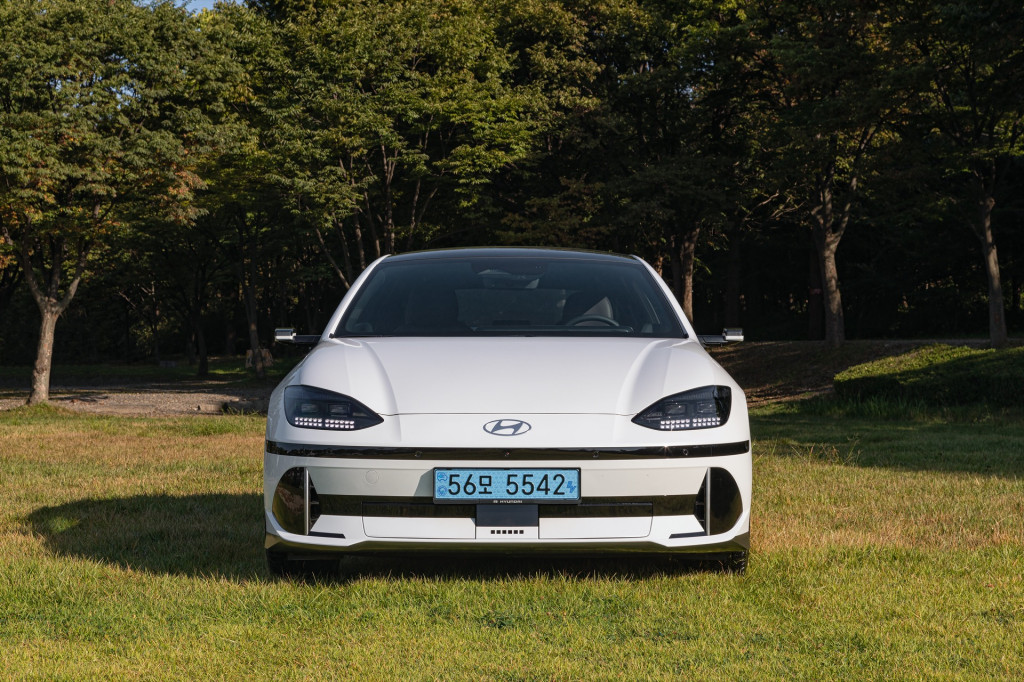
2023 Hyundai Ioniq 6
It’s a trendsetter, looks even better up close, and from first impressions, it suggests for the first time that there’s a car that one-ups the Tesla Model 3 in many respects. Just you wait.
One curve, many details
It would have been easy for the Ioniq 6 to mimic the best-selling Tesla Model 3, or to simply aping the Ioniq 5 hatchback that’s in ridiculously short supply. But Hyundai didn’t opt for either of those routes.
Hyundai calls the profile of the Ioniq 6 “one curve.” Side profile pics tend to show individual arcs, but in person it’s easy to figuratively lay a French curve across any portion of the car as a whole. The thing is curvy everywhere. Influences include the Stout Scarab and the Phantom Corsair, both from the 1930s; and the 1950 Saab 92; and a 1920s aviation aesthetic in this “streamliner.” Yet to anyone fluent in modern cars, it’s impossible not to see some Porsche influences in front and in back. Is that a whale tail?
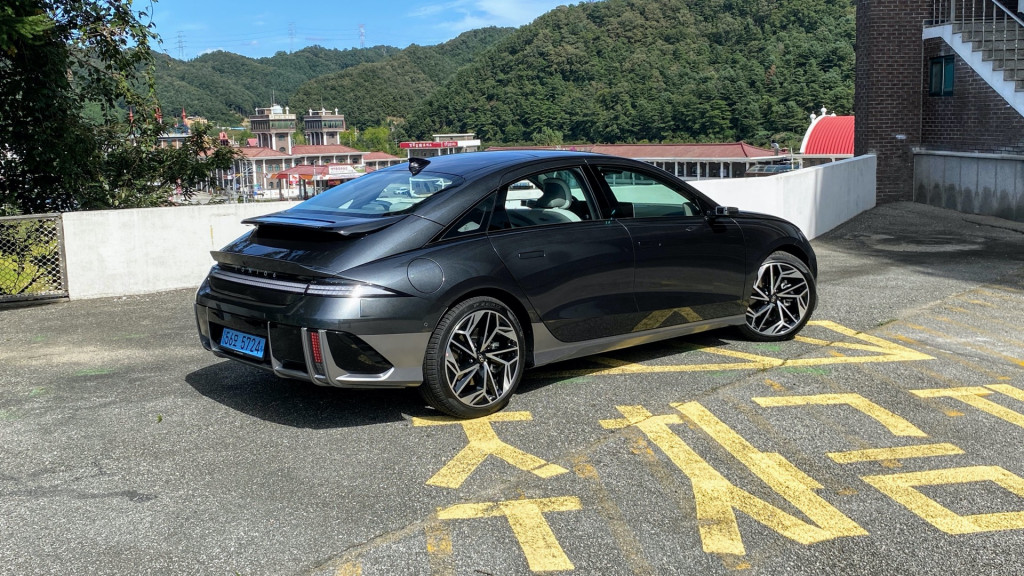
2023 Hyundai Ioniq 6 first drive – South Korea
Well, it’s a rear spoiler that plays a key role in the 0.21 coefficient of drag, making the Ioniq 6 Hyundai’s most aerodynamic production car ever. Modeled after the super-marine spitfire British World War II airplane, it’s one of those elements of beauty where engineering and design find the sweet spot. Don’t try removing the spoiler if you value your highway range. The aero advantages are also made possible by an active air flap at the lower front air intake, letting airflow through and around the front wheels—and, by the sound of it, a whole lot of modeling and wind-tunnel work.
On the outside, Hyundai’s so-called parametric pixel design details, the emphasis on lighting, and the slim door handles are about the only things in common with the Ioniq 5. That’s how Hyundai likes it, in an Ioniq lineup of models that will each make their own statement, including the boxy Ioniq 7 SUV that’s on the way as well.
No wasted space
The Ioniq 6 is the first sedan built from the company’s E-GMP dedicated electric vehicle platform. It’s also the first Hyundai model to offer over-the-air firmware updates for the full gamut of vehicle functions.
It rides on a 116.1-inch wheelbase and is 191.1 inches long, 74.0 inches wide, and 58.9 inches tall. In overall height, the Ioniq 5 is only about four inches taller than the Ioniq 6, but with them both at opposite sides of a garage you’d guess there’s more of a difference.
Hyundai has conceived each of the Ioniq models separately, with an emphasis on an interior “living space,” parametric pixel cues peppered throughout to unify the different looks, and sustainability in tech and materials.
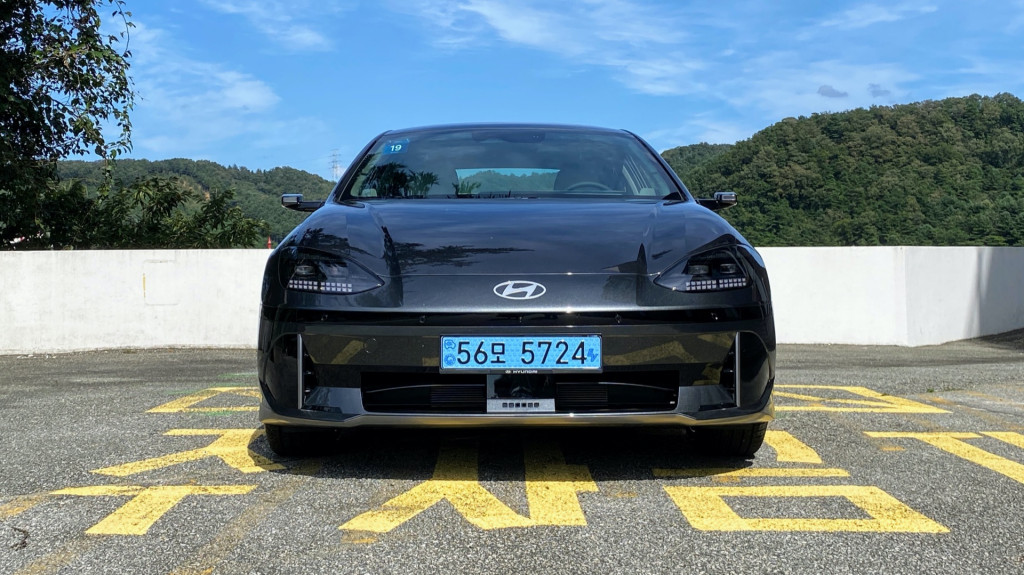
2023 Hyundai Ioniq 6 first drive – South Korea
According to Hyundai global design chief Simon Loasby, controlling the visual height of the car was very important. The broad arc that assures passenger space gets where it needs to be, but it starts very low in front and back.
Just as with the Ioniq 5, the dash is pushed forward more than in other vehicles, and the entire front floor space feels open and airy. Like the Tesla Model 3, there isn’t a lot of wasted space atop the dash, and from an upright driving position the hood pretty much disappears, leaving a great view ahead. Twin 12.3-inch displays stand upright in front of the driver—the one in the middle a touchscreen for infotainment, the one ahead for gauges—but they’re by no means in the way.
The skateboard platform and long wheelbase pay dividends in passenger space. The floor is flat throughout the cabin, bringing excellent leg room to the back seat, even when the front seat is back all or nearly all the way. Just don’t expect a lot of headroom; I (and anyone over six feet tall) was pressing my noggin against the headliner, requiring a hunched-forward position that would be acceptable for a trip across town but not a road trip. Up front, Hyundai adds a sturdy, two-tiered center console; it doesn’t move around like the one in the Ioniq 5, but there’s space for larger items below plus the top area is level and good for a laptop, they say.
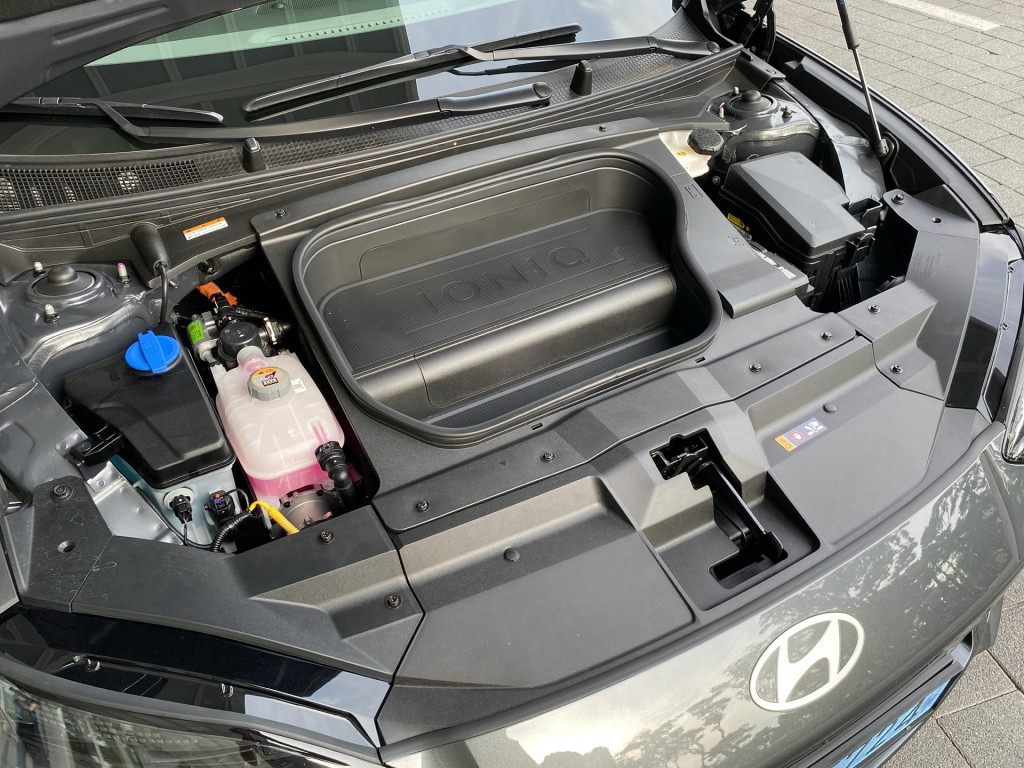
2023 Hyundai Ioniq 6 first drive – South Korea
There is a frunk, but it’s essentially a small storage bin, good for charging cables or maybe a laptop bag. The trunk isn’t very deep—just enough for grocery bags, although it’s wide and long.
Not a sport sedan but nicely balanced
Rear-wheel-drive single-motor versions of the Ioniq 6 make 225 hp and 258 lb-ft and all-wheel-drive dual-motor models make 320 hp and 446 lb-ft. Hyundai claims a 0-62-mph acceleration time of 7.4 seconds in single-motor form and 5.1 seconds in dual-motor form, although its factory acceleration times are typically conservative.
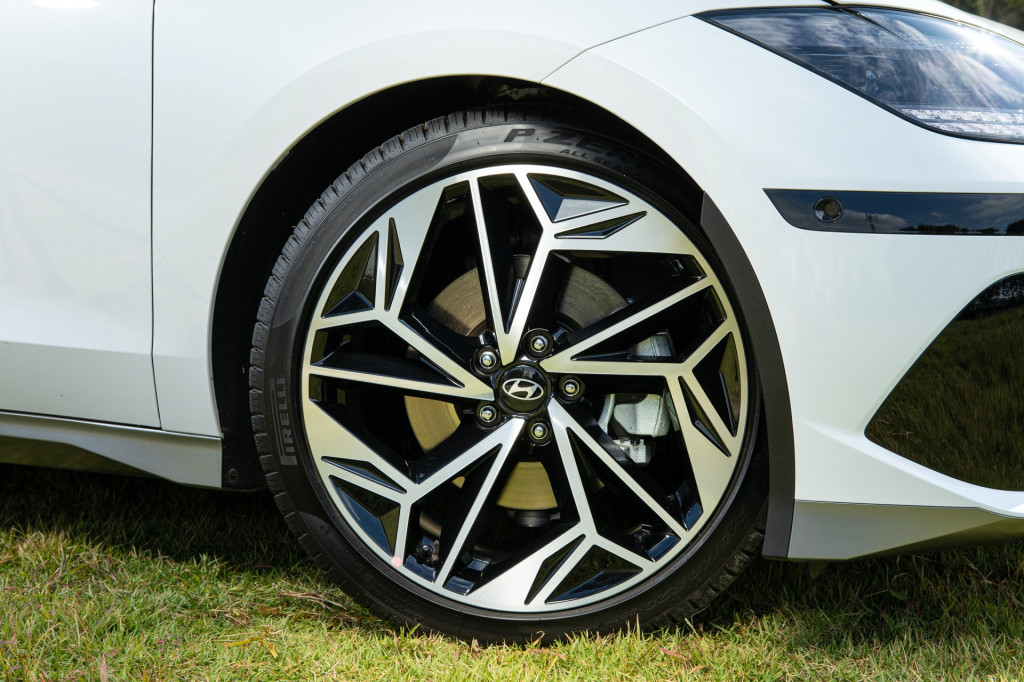
2023 Hyundai Ioniq 6
Our well-equipped dual-motor model with 20-inch wheels felt plenty quick in this world of “instant torque,” and the motors and traction system never needed the Pirelli P Zeros to scramble for grip. What would this vehicle be like with a firmer suspension and the higher-output 576-hp dual-motor layout of the Kia EV6? While exact horsepower figures are still TBA, that vehicle is in the works as the Ioniq 6 N. It’s one to look forward to, given the Ioniq 6’s lower, more planted feel.
The Ioniq 6 is by no means firmly tuned. We’d call it a scosche firmer than the 5, but since you’re lower you don’t feel the roll as much. Steering feel is light and easy, and it returns to center well. It’s at its best in tighter corners, where it weights up nicely, but it could use a little more precision in how it unwinds out of them. Versus the Ioniq 5 and pretty much the whole cohort of electric crossovers, you sit more in the car rather than on it—and that makes a huge difference in perception as you corner quickly and enjoy driving.
The 6 gets hydraulic bushings in back to help soak up road harshness, as well as frequency-sensitive shocks with variable flow paths, to allow them to react differently to varied inputs. The integrated drive axle has a hub-integrated outboard joint to help aid stiffness. The Ioniq 6 also uses low-noise tires, a carpet/floor that’s decoupled from the structure, and various sound-absorbing materials. Acoustic glass is used for the windshield and front and side door glass, and smooth shielding keeps the underbody free of turbulence.
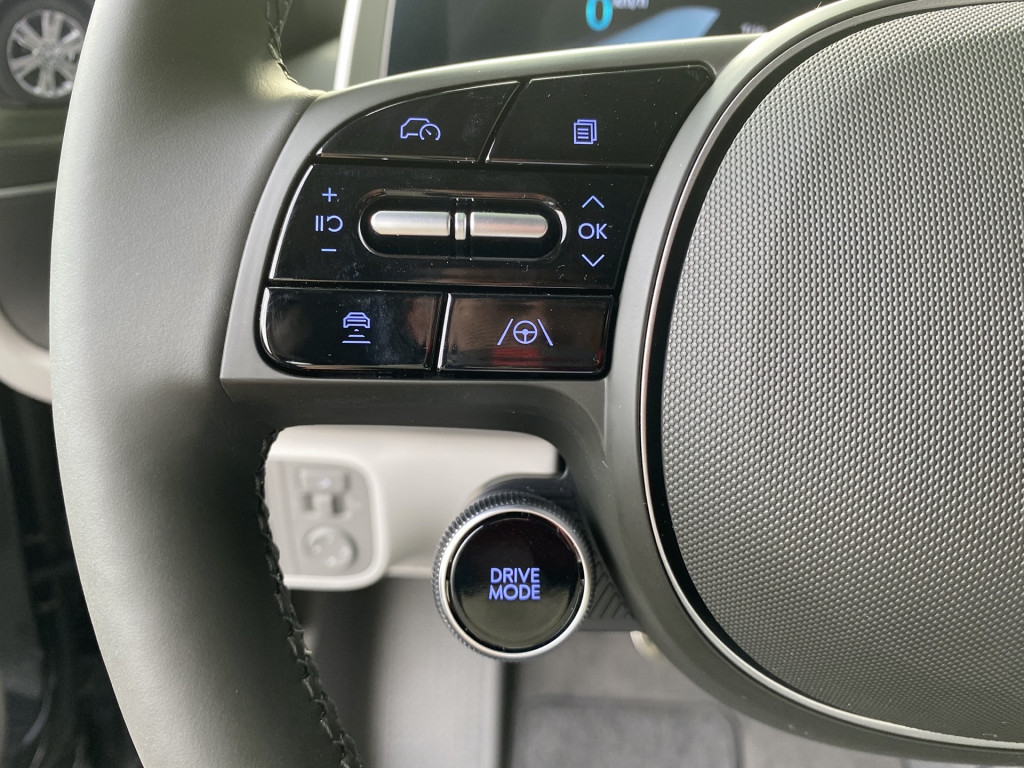
2023 Hyundai Ioniq 6 first drive – South Korea
Four levels of regenerative braking, all steering-wheel paddle-selected, plus smoothly blended brakes make it easy to find the best experience for each driver. An Auto Hold mode simply toggles on and off with its own button, allowing drivers to give the brake pedal a rest in traffic as desired. Hyundai also provides Eco, Normal, Sport, and Snow modes, as with the Ioniq 5, but new to the Ioniq 6 is an EV Tune-up feature that allows the owner to tweak more of the settings individually—including steering, acceleration sensitivity, and horsepower.
As I tested the Ioniq 6, it likely has a curb weight of around 4,500 lb, which is several hundred pounds heavier than the Model 3 Long Range.
Tech, some of it inbound
My test car—actually, all the test cars—had a tech item that won’t come to the U.S.: camera-based side rearview mirrors. With screens mounted at the edge of the dash, on wings that extended upward from it. The setup gives drivers a wider angle of view than standard rearview mirrors. I found it a lot easier to get used to than the screen-based center rearview mirrors offered in a few U.S. models. My only caveat is the boxy execution of the camera unit on the outside; it didn’t fit in with the rest of the coordinated, super-aero design. We’ll take our standard mirrors and grin, thank you.
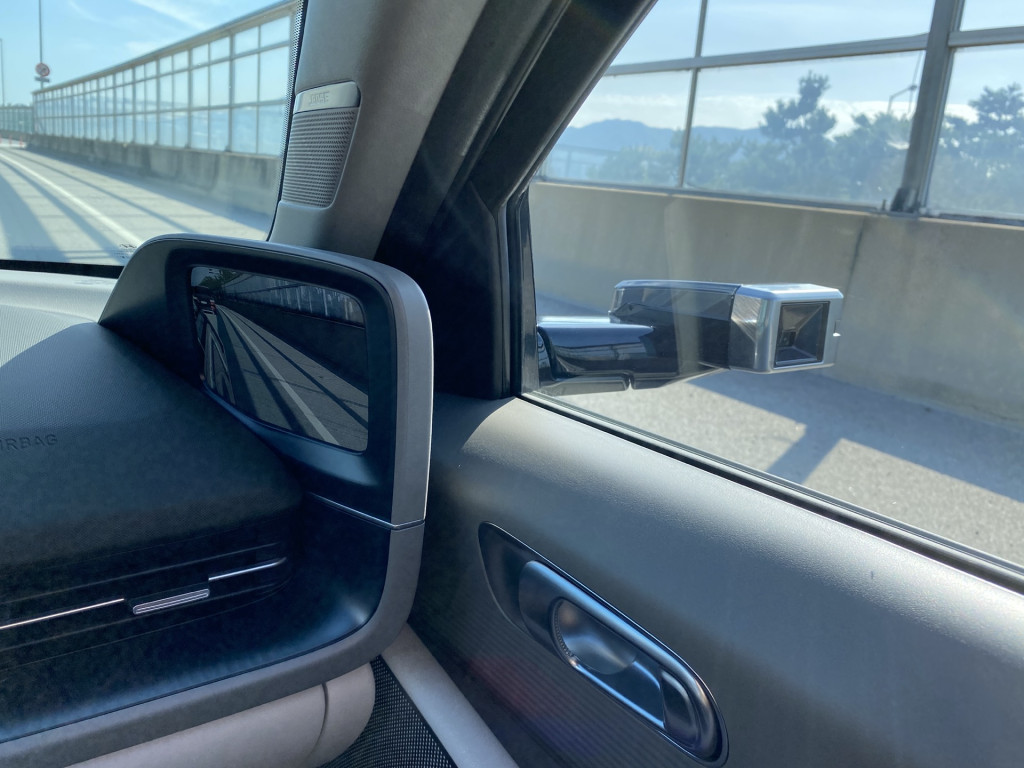
2023 Hyundai Ioniq 6 first drive – South Korea
The Ioniq 6’s 800-volt charging capability means that, like the 5, it will be able to take advantage of 350-kw DC fast-charging stations, getting either of its battery packs from 10% to 80% in just 18 minutes. Both a heat pump and battery heating system are included, as is a new preconditioning system that should make peak charge rates easier to access in chillier weather.
With its 11-kw onboard charger, the Ioniq 6 can get a full charge in about six hours for the Standard pack or about eight hours with the Long Range pack—eight and 12 hours, respectively, with more common 7.0-kw garage wallboxes. It comes ready for bidirectional charging and will feature a similar Vehicle to Load (V2L) connector allowing owners to power appliances or camping equipment, or to slow-charge another EV.
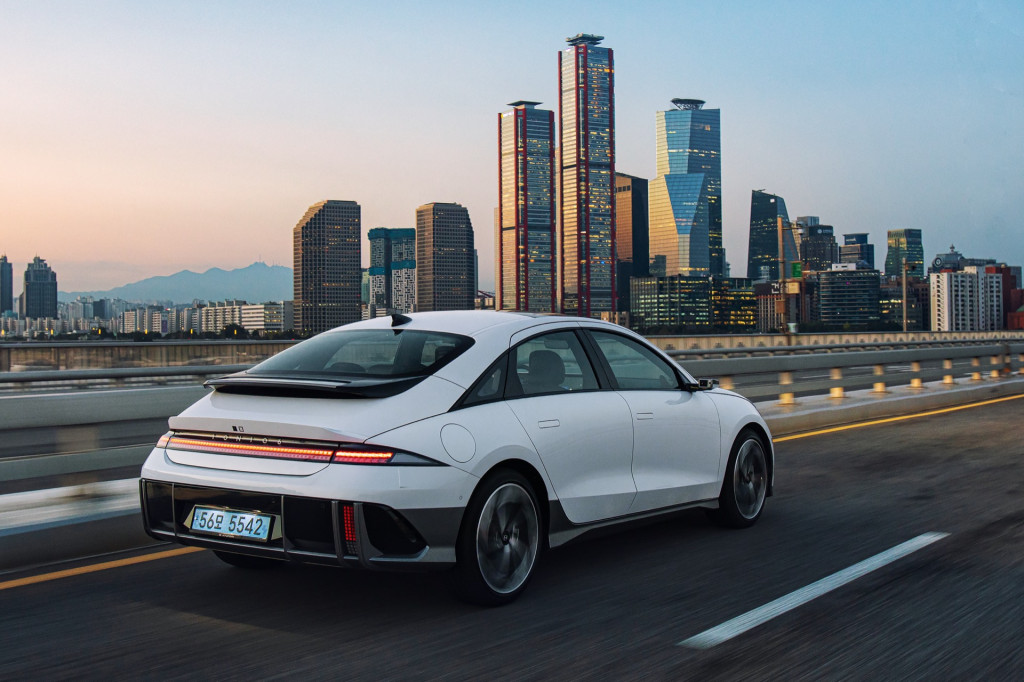
2023 Hyundai Ioniq 6
Hyundai hasn’t provided much guidance on the base price of the Ioniq 6, which will arrive in early 2023 for North America, after a rollout in Korea this fall. But to combine a few hints from company officials, we expect it to start slightly lower than the Ioniq 5 but top out somewhat higher in its top-performance Ioniq 6 N form. Think $40,000 to $65,000, approximately. This isn’t going to be an expansive luxury car, but it feels like it.
Most importantly, the arrival of the Ioniq 6 will finally provide competition for the Model 3. Provided Hyundai builds enough of these, we’re eager to see how this rivalry plays out.
–
Motor Authority accepted travel, meals, and accommodations in a very tall building to bring you this report.
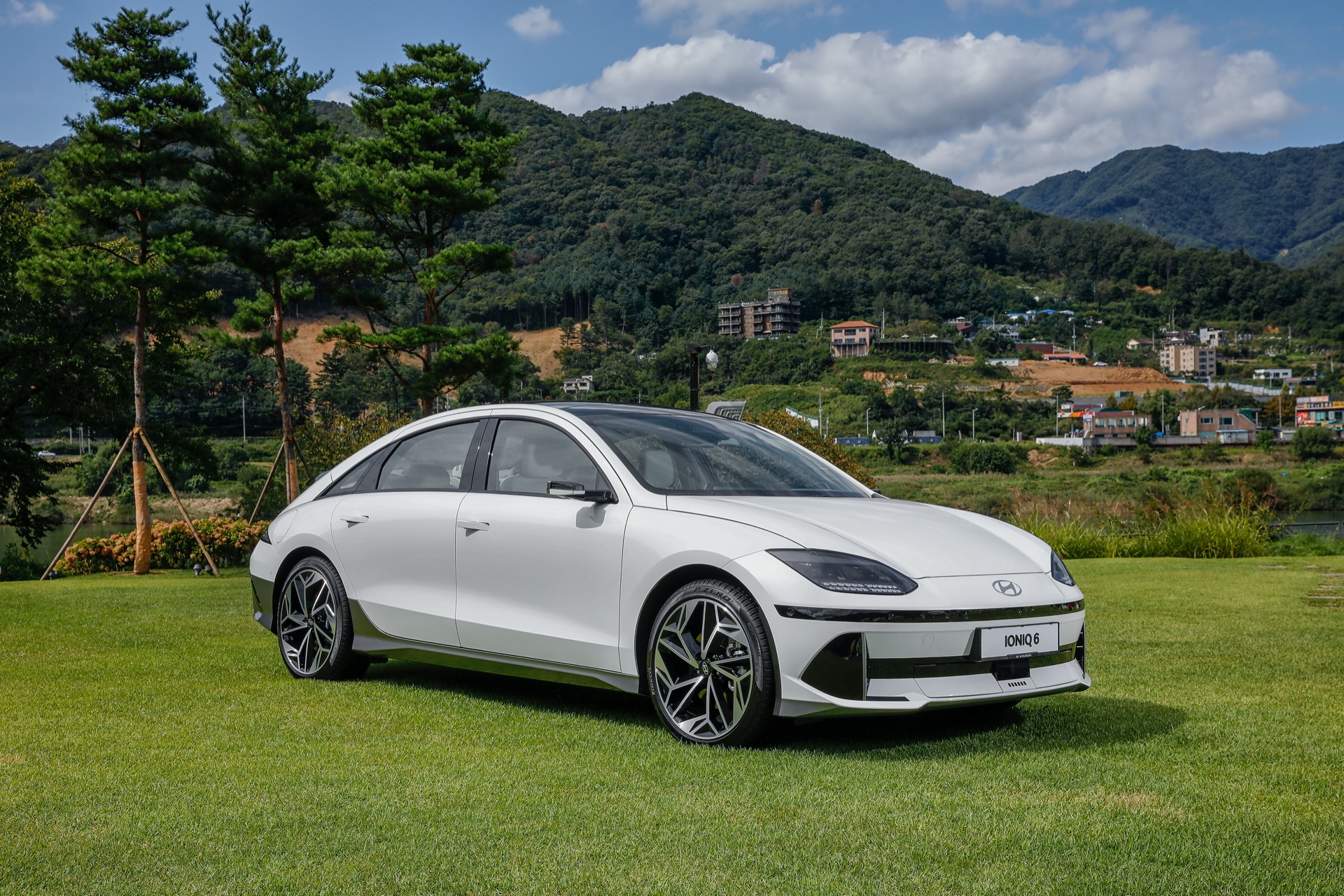
stromectol where to buy – ivermectin 6 mg for sale carbamazepine 400mg us
cheap accutane 10mg – decadron for sale cheap zyvox 600mg
amoxil medication – buy valsartan 160mg pills ipratropium 100mcg usa
buy zithromax medication – bystolic 5mg uk nebivolol where to buy
order prednisolone 20mg generic – prednisolone 10mg tablet buy progesterone for sale
purchase gabapentin for sale – where can i buy clomipramine oral sporanox 100mg
furosemide 40mg usa – lasix 40mg without prescription betnovate over the counter
acticlate usa – glucotrol canada order glipizide 5mg pill
cheap rybelsus – periactin 4 mg tablet purchase cyproheptadine
how much is cialis – cialis 10mg cost viagra 50 mg
where to buy cenforce without a prescription – cost chloroquine 250mg order glycomet online
prilosec 20mg canada – buy metoprolol online cheap atenolol 50mg brand
The half kneeling position with its slim base of support increases the demand of
the core and hip stabilizers. And pairing this with the
Pallof press adds to this because the stabilizers should fight the added rotational
forces. The half kneeling place wants good hip flexion, hip extension, and core stability to do well and
the Pallof press makes this higher. By incorporating
the Pallof Press into your workout routine, you’ll have the ability to reap the advantages
of a stronger, more stable core, lowered injury threat, and improved practical power.
Bear In Mind to give consideration to correct type, avoid frequent mistakes,
and steadily progress to tougher variations to maximise
your results. Pressing overhead instead of laterally makes the tall kneeling overhead
Pallof press an anti-rotation and anti-low again extension train. A standard error when overhead urgent is a
too much lower again extension to finish the motion.
I Am Going To often see people set up for the Pallof, extend
their arms shortly, then pull their arms back. By not lingering with the arms extended,
they’re failing to essentially get the total advantage of the Pallof.
More time in the arms-extended place can be better; do not be afraid to live there for, say, three
to 4 seconds. The Pallof press is a should
have stability and development exercise that must be integrated into your training routine/s from this
point on if you’re not doing it already. To do this motion, merely
position yourself in the bottom of a lunge with one leg in entrance, and the other behind your body with the knees bent.
The commonest variation to the single-leg version of
the Pallof Press would be the double leg version, with each ft planted firmly on the
bottom. In this guide, I’m going to show you the way to do
a Single Leg Pallof Press, what muscle tissue it works and a few alternatives if you’re unable to do them.
Total, the Pallof press is a good way to construct a more healthy, tones body, and to keep away
from long term, chronic injuries and pains. We observe a detailed, rigorous, multi-step process
to create content that meets the very best requirements
of clarity, practicality, and scientific integrity.
He also holds an Train Science degree from Otterbein School where he was captain of the soccer staff.
If you don’t have entry to a band to do Pallof Presses, an excellent alternative to warm up the core and likewise work glute activation can be Lateral Bridges.
Russian twists are body weight actions that primarily work the abs and obliques.
This exercise can be done anyplace in case you have out there floor area and without any equipment.
However, you ought to use a drugs ball, kettlebells, dumbbells or a resistance band for more resistance.
In addition, the place with one knee on the ground and
the other foot forward, ensures that both
sides of the physique will be worked equally.
In addition, banded variations often add an extra component of muscular effort and management since you will need to maintain up the consistency of rigidity all through the train.
One of the most important advantages to the banded Pallof Press compared to cable
variations is the comfort and portability – mainly you
can carry a band anyplace. As a outcome, banded
variations are appropriate for home workouts, on the go,
or the health club.
He can be the chief tester for health trackers and operating watches,
treadmills and exercise bikes, and workout headphones.
Now, carry the hips off the bottom to attain the full aspect plank place.
The Kneeling Pallof Press is a variation where we are varying the beginning place.
Lighten up the resistance in order that your core can deal with all the work itself.
Follow these form cues to discover ways to do the Pallof press more safely.
Once you’ve read the step-by-step directions, follow alongside for some higher-level ideas from Samuel to dive deeper into the train. Use a weight that lets you keep a steady torso all through the exercise.
These muscular tissues are essential in workout routines that require
important core engagement, corresponding to squats,
deadlifts, and overhead presses, and this is exactly
the place the beginning of this text shines.
The cable Pallof Press utilizes a cable machine to provide constant resistance throughout the motion. As a end result,
you will want to avoid turning your torso or hips during the movement.
Here are four variations that anybody can add to their
core coaching regimen. Not Like traditional core exercises that contain bending or twisting,
the Pallof Press focuses on stability—helping you construct
a strong, supportive core without placing extra pressure on your backbone.
If you’re managing osteoporosis, strengthening your core muscular tissues is probably certainly one of the best things you can do to protect
your backbone, improve stability, and reduce the chance of fractures.
If you want an evenly outlined midsection, you should
be coaching your core not solely to perform rotations, however to withstand them.
In short, it’s a win-win, for looks and performance, that you
don’t wish to skip. Often carried out utilizing dumbbells,
the renegade row develops unilateral power.
References:
risks of taking steroids
buy misoprostol 200mcg online – purchase misoprostol pills purchase diltiazem pills
70918248
References:
What Steroids Should I Take (http://Www.Jinlingnas.Top)
buy domperidone 10mg – motilium 10mg generic purchase flexeril generic
My passion has all the time been bodybuilding but with 15 years’ expertise
in weight loss packages too, it’s hard to not mention all that if you’re
working at your fitness level fullest (I hope). When Im not in the gym or spending time away from
my family i typically take into consideration what
advice would assist others achieve theirs objectives similar to these impressed mine.
While Anavar is usually considered a safe drug for men, it
may possibly nonetheless cause undesirable unwanted effects.
Widespread side effects of Anavar include acne,
hair loss, decreased libido, and decreased testosterone manufacturing.
Anavar, also referred to as Oxandrolone, is a popular anabolic steroid that
is often used to enhance athletic efficiency, build
muscle, and enhance endurance. If you may be considering using Anavar, it’s important to grasp the correct
dosage in your specific wants and objectives.
Nonetheless, it’s essential to reiterate that the potential for side effects must be rigorously evaluated and monitored.
The usage of this potent substance must be done
judiciously, with a concentrate on figuring out the suitable dosage and period for every individual’s unique
wants and objectives. In the following decades, this artificial hormone’s popularity continued to
grow among feminine bodybuilders. Its low-androgenic properties and lower threat of
virilizing effects, similar to deepening voice and extreme hair progress, made
it a more attractive choice when in comparability with
harsher anabolic steroids. Many professional and amateur bodybuilders appreciated
Anavar for its ability to extend muscle hardness and density without compromising their femininity.
We have noticed this duo produce notable fat loss and moderate will increase in lean muscle mass, ranging from 10 to 20
pounds.
However notice that long-term use and a high dose of Anavar might trigger numerous unwanted aspect effects, so avoid it.
Ladies typically don’t stack Anavar with one other steroid
for fear of virilization. Nonetheless, males typically stack it with different anabolics and are in a place to obtain great results too.
In spite of being a robust slicing steroid,
Anavar is amazingly effective at enhancing strength too.
One of the most essential components that’s easily missed
when taking a glance at earlier than and after photos similar to these above
is the strength features that Anavar brings with it.
It’s important to note that individual outcomes can differ extensively based on elements corresponding to food regimen, train,
genetics, and the precise dosage and length of the cycle.
Novices commonly take Anavar, an oral compound, as a result of its lowered toxicity compared to other steroids.
Whereas trenbolone is a severely poisonous injectable, largely administered by superior steroid customers.
However, masculinization is frequent if a female increases the Winstrol dose or extends this cycle beyond six
weeks. Nonetheless, it is necessary to conduct routine sphygmomanometry tests because
of the chance of elevated blood pressure.
We have noticed muscle gains of roughly 25–30 kilos when average doses of testosterone and Anavar are
administered to novices. Testosterone is an FDA-approved medicine (2), which means that
its side effects could additionally be manageable when taken underneath the steering of a
qualified doctor. However, in 2023, it was withdrawn from the US market as a result
of security issues, specifically regarding potential risks of peliosis hepatis, atherosclerosis, hypercalcemia,
and prostatic hypertrophy in patients.
However, it’s value noting that the muscular tissues
won’t significantly deflate on Winstrol, despite
a reduction in water quantity, because of it concurrently including muscle hypertrophy (size) throughout a cycle.
The chemical structures of Winstrol and Anavar are similar, with each compounds being modified forms of
dihydrotestosterone. They also possess a methyl
group on the carbon 17-alpha place, serving to to protect biological availability upon administration. Beneath is every thing you
want to know regarding the professionals and cons
of these two compounds, how they compare, and which can be extra optimal primarily based in your goals.
Yes, in this occasion, we will gradually decrease
a affected person’s dose to minimize antagonistic results upon discontinuation.
Anavar is unique as a result of it has great oral bioavailability (can be taken my mouth) and is immune to liver
metabolism. Anavar additionally doesn’t get aromatized into estrogen compared to testosterone.
In a mixed cycle that includes Anavar, the dosage generally ranges between forty to 60 milligrams per day.
In this text, I will cowl the advantages ladies
can count on from taking authorized Anavar.
Nonetheless, in my view, the easiest way to avoid any and
all unwanted side effects are to keep away from Anavar in any respect cost.
If you find that you are tolerating it nicely, you can extend your cycle length.
Lastly, you have to just make sure you are taking Anavar at
the right time of day. If you select to inject Anavar, you should
make sure that you are injecting it into a muscle that has loads of blood flow.
The tablets are available in numerous sizes and the dimensions will differ from one producer to another.
With this steroid, ladies are inspired to make use of
lower doses than their men counterparts, usually going for 10mg or 20mg while most men will go for 50mg.
You can also stack Anavar with steroids like Winstrol, Clen, and Trenbolone for cutting functions.
As a basic rule of thumb, most Anavar cycles must be between 4 and eight
weeks in size. If you would possibly be utilizing Anavar for
slicing purposes, you will want to make use of it for a shorter time frame than in case
you are utilizing it for bulking purposes. It can take a number of weeks for the drug to build up in your system and
produce results. Nevertheless, some folks do expertise
benefits within the first week or two of taking it.
Sustanon 250, produced by Organon, is an anabolic steroid that accommodates
a blend of 4 testosterone esters, delivering a staggered release of the hormone post-injection. Primobolan is an orally active anabolic
steroid that binds to and stimulates Androgen Receptors in the muscle tissue.
In fact, if you will start with any anabolic steroid on a cutting cycle, that
is in all probability the one you need to go for.
Even if you’re cutting…providing you’re training onerous, consuming right, and
using other powerful steroids alongside primo, it’s actually attainable to build
a noticeable amount of muscle on Primobolan. Because of this many of the ‘hardcore’ bodybuilders have a
tendency to use extra poisonous steroids, as a end result of on paper it’s a
weaker compound. However, don’t let that fool you, as a result of
when Primo’s used appropriately, it may give you some serious
positive aspects. The cycle that features both Anavar
and Winstrol typically begins with smaller dosages
of both substances to gauge the body’s initial reaction.
And if you’re in search of options to Anavar with TRT – that’s authorized and safer – natural steroids are choices I
could actually beat my chest and advocate to you. Different people feel that
pure steroids are a better various because they aren’t as more likely to trigger unwanted facet effects.
The use of high dosages of Anavar together with TRT is not really helpful and is considered outside the scope of respectable medical practice.
In a respectable medical setting, a low dosage
of Anavar in combination with TRT could range
from mg per day. Again, in a respectable medical setting,
the appropriate dosage of Anavar with TRT will rely upon various components, including the
patient’s particular person medical situation, age, weight, and
response to remedy. TRT also can have unwanted side effects, corresponding to elevated pink
blood cell count, acne, sleep apnea, and fertility points.
It’s also price mentioning that each TRT and Anavar have
potential unwanted effects.
The following testimonies are accounts of how users have gotten on with combining Anavar and Winstrol.
Nonetheless, it’s of pivotal significance to underscore
that any mixture of drugs must be undertaken with warning.
Ensure that a daily check on health parameters is set in place,
and any sudden or disturbing changes should warrant instant reevaluation of the mix.
When it involves an Anavar and test cycle, there are a couple of things you
can do to be sure to get probably the most out of your steroid use.
By following these guidelines, you’ll have the ability to decrease
your risk of unwanted effects and maximize your outcomes.
Some individuals may be tempted to venture past
the really helpful thresholds in the pursuit of extra impressive
positive aspects. This emphasizes the significance of sticking to responsible dosage
parameters. Given its highly effective anabolic nature,
even minor adjustments can result in noticeable changes in outcomes and potential unwanted
facet effects. It’s pivotal to tread with caution, persistence, and an understanding that there’s no shortcut to achieving your fitness targets.
References:
how are steroids used
order motilium 10mg generic – motilium for sale order cyclobenzaprine for sale
This steroid is often utilized by athletes and bodybuilders to enhance power
and efficiency, nevertheless it comes at a high worth.
The steroid is popular among bodybuilders and athletes who want to acquire an edge over their competition. Muscle Acquire Prescribed Drugs also offers thorough product information and
dosage pointers, enhancing client confidence and
security.
Anabolic steroids are composed of testosterone merchandise (male intercourse hormones) and so they generally enhance muscle mass and improve athletic
performance. Even though anabolic steroids could be misused and cause unwanted side effects, they provide nice scientific
advantages when used therapeutically. Anavar is a
powerful software for anybody looking to enhance their physique, whether it’s for aggressive bodybuilding, athletics, or personal health targets.
Even although I put in a single quantity, a totally totally different issue many was within the
transaction. †These statements have not been evaluated by
the Food and Drug Administration. This product just isn’t
supposed to treat, remedy, diagnose, or stop any illness.
These statements haven’t been evaluated by the Food
and Drug Administration. This product isn’t meant to diagnose, treat, cure, or forestall
any disease. Nevertheless, in case if misuse, sudden stoppage might lead to withdrawal
symptoms corresponding to irritability and despair.
Whereas thought of one of many milder oral steroids,
high doses or prolonged cycles can pressure the liver.
US fitness consultants suggest supplementing with milk thistle or N-acetyl cysteine (NAC)
to assist liver detoxification. Additionally, users are advised to endure liver operate checks before,
during, and after their cycle to monitor enzyme levels.
Anavar’s manufacturers will all the time label it to be used
as directed by your physician; however, most individuals using it don’t examine into the doctor’s workplace.
Two tablets a day remain our advice, some people have been noticed to take as a
lot as 4 tablets a day. This could presumably be a type of abuse; nevertheless, dosage ought to tally with the bodybuilding
objective.In the case of Anvarol, the manufacturer prescribes three capsules a day.
Anavar is tremendously appreciated by many athletes for a few specific causes.
This steroid will increase power; the whole increase won’t be as important as
steroids like Dianabol and nowhere close to the extent of Halotestin, but it is going to
be notable. Energy is doubtless one of the primary components of
profitable athleticism because it interprets into pace and energy.
Athletes also appreciate Anavar because of the truth that it won’t produce a large buildup
in mass. In some circumstances, added mass could be a hindrance relying on the game, and in other cases, it will bring about prying eyes that no athlete desires on them.
When we additional think about this steroid can not lead to water retention, a attainable
burden to many athletes, Anavar relaxation as one of the
prime athletic decisions. Nonetheless, despite
the authorized restrictions, it’s nonetheless comparatively simple to acquire
steroids in Mexico.
Similarly, intermediate female users chart their Anavar journey inside a 6
to 8-week cycle length, accompanied by a every day dosage ranging between 10mg and 20mg.
This thoughtful method is indicative of a continued emphasis on caution, whilst customers progress to more
prolonged cycles. The major objective for female customers during this intermediate stage is to strike a steadiness between attaining desired outcomes and making
certain the maintenance of a safe and efficient dosage vary.
Folks typically ask us what type of results they can anticipate taking
Anavar. It’s important to stress there isn’t any such factor as a magic capsule or a magic bullet when taking fat burners
or prohormones. It will rely in large part on the way
you eat, what your diet intake is, how exhausting you train. Most customers of Anavar find they’ll improve
muscle dimension, muscle voume, and total power.
Accountable utilization of Anavar is vital to maximizing
its advantages whereas minimizing potential risks. Understanding correct cycles, dosages, and post-cycle necessities ensures a secure and effective experience.
Nutritionists specializing in performance-based diets within the US recommend pairing Anavar cycles with a high-protein, moderate-carb diet to maximize muscle retention. Foods like lean hen breast, sweet potatoes,
and spinach are staples within the diets of American health enthusiasts utilizing Anavar.
Hydration can additionally be emphasized to help kidney health, given Anavar’s potential to increase
creatinine ranges. Medical reviews from US-based hepatologists
reveal Anavar’s impact on liver enzymes is dose-dependent.
This steroid could be stacked easily with others to enhance its
effects or decrease the unwanted effects caused by the most powerful steroids.
The flexibility with which it can cater to different objectives similar to chopping, bulking,
or enhancing general athletic performance makes it loved by
the body-building circle. This has contributed to why it’s still recognized at present because it could
possibly collaborate with varied steroids and doesn’t impose much strain on the
body. When it comes to buying Anavar on-line, the supply is simply as essential
because the brand. With so many online shops claiming to promote genuine merchandise, it’s easy to fall into
the trap of purchasing counterfeit or low-quality steroids.
These three compounds are structurally and biochemically
comparable and have been proven to extend protein synthesis significantly.
We provide one hundred pc pharma grade Var products supplied by
prime internationally renowned pharmaceutical companies.
Anavar is hepatotoxic by nature and exceedingly lengthy cycles might result in liver-related well being points.
In abstract, approach your Anavar journey with an knowledgeable and discerning mindset.
Prioritize authorized and protected acquisition, keep devoted to your fitness goals, and
remain constant in your efforts. By doing so,
you set the inspiration for a balanced and accountable strategy to incorporating Anavar into your health
routine. Adhering to prescribed dosages and incorporating post-cycle remedy (PCT) protocols after
the completion of a cycle can aid in restoring pure hormonal stability, decreasing the danger of lingering imbalances.
By enhancing nitrogen retention, Anavar creates
an surroundings conducive to muscle development and preservation.
The Anavar market is competitive, and counterfeit merchandise pose a severe menace to your well being and pockets.
In 2024, it’s very important to pick suppliers
who prioritize high quality, transparency, and customer satisfaction. Professionals can provide
steering on proper dosage, cycle lengths, and potential drug interactions.
Consulting specialists can considerably enhance the protection of your
Anavar use. They can offer steerage particular to your well being wants, guaranteeing
a safer experience.
References:
T Ball Steroid
As A Result Of it’s an oral steroid, Anavar may be toxic to the liver when used over
lengthy durations of time at extreme dosages. Athletes utilize
Anavar to increase athletic performance, promote muscle
and energy gains with none water retention. It can be an anabolic steroid
used extensively by bodybuilders wishing to shed body fat and keep
as much muscle as attainable throughout a caloric deficit.
Steroidsstores offers high-quality Anavar Oxandrolone 10mg tablets at one of the best costs.
PrecisionAnabolics only makes use of the purest pharmaceutical-grade components available to promote
the increase of lean body-mass, energy, fat loss, and enhanced athletic performance.
By No Means under-dosed, substituted, or mislabelled, the active-ingredients in our merchandise are chemically engineered to promote the specified therapeutic-effect specific to every product, each time.
Flex Lewis, a distinguished bodybuilder and multiple-time Mr.
Olympia winner in the 212 division, has overtly shared his positive experiences with Anavar.
Superior users may think about 60-80mg per day, however this choice requires cautious monitoring of
their body’s reactions. Vigilance and sufficient fluid consumption are essential
when exploring higher dosages, balancing the pursuit of enhanced outcomes
with accountable utilization. By following these tips, you’ll find a way to improve
your chances of acquiring a dependable and protected Anavar product.
Please observe that individual experiences may vary, and it is necessary to exercise
warning and seek the advice of with professionals when making buying selections.
It is price noting that intermediate and advanced Anavar cycles usually extend beyond eight weeks, starting from 10 to 12 weeks.
Nonetheless, the precise length ought to be based on individual objectives,
experience, and total well being. Anavar also has a fat-burning effect, as it
could increase metabolic price and goal visceral fat.
Best for both chopping and bulking cycles,
incorporate it into your routine to experience the maximum benefits.
We suggest you discover what is the cause behind Oxandrolone’s ability to offer such efficient results.
First, Anavar stimulates the appearance of new purple blood cells within the
blood. This allows for improved endurance throughout heavy
workouts in the health club.
This submit informs bodybuilders and athletes in general,
on which on-line sites they will trust to buy oral and injectable steroids.
It helps to increase muscle mass and strength, in addition to improve athletic performance.
It increases the quantity of protein the body makes, which outcomes in weight achieve by building extra muscle.
It has been a extensively used, respected and very popular steroid
for a really lengthy time and is one of the few that can additionally be used by females because of its gentle androgenic
results. Whereas Anavar is mildly toxic to the liver, as we would expect with an oral steroid, its hepatotoxicity level is minimal compared with many different steroids,
making this a perfect alternative for beginners. The safety or effectiveness of the steroid
can also be affected by elements like age and gender. Overusing
steroids might also have some dangerous results in your body.
Thus it’s pretty widespread for individuals to get scammed when trying to buy anavar.
As a outcome, the chance is even higher when making an attempt to obtain this steroid as dealers usually cut the dose without you knowing, or promote you fillers to increase their revenue margins.
Drugs similar to finasteride can be used to considerably reduce
DHT ranges in the physique, reducing hair loss.
Nevertheless, this will likely lead to decreased muscle features,
as DHT is a very anabolic hormone. Anavar does spike dihydrotestosterone (DHT) ranges which might
contribute to acne and hair loss. The reason why zits can occur on Anavar is
as a result of DHT triggers the androgenic receptors in your pores
and skin leading to elevated sebum manufacturing and body hair whereas suppressing hair progress on your head.
Using Anavar responsibly ensures optimal outcomes whereas defending your health, permitting you to realize your fitness targets
safely. Anavar enhances glycogen storage
in muscle tissue, providing a available vitality source during intense training.
This help accelerates restoration by reducing muscle soreness and getting ready the muscles for the subsequent
exercise. Faster restoration times allow for extra frequent and
productive training sessions, optimizing long-term progress.
The successful cutting cycle for beginners relies on the holistic integration of Anavar with dietary measures.
Remember, managing unwanted aspect effects is a
proactive process that requires accountable use, open communication with healthcare professionals, and self-awareness.
By prioritizing your well being, monitoring your body’s response, and looking for guidance when needed,
you can reduce dangers and optimize the advantages of Anavar usage.
When it comes to purchasing Anavar (Oxandrolone), it’s crucial to navigate the market properly to make certain you obtain a genuine and high-quality product.
Oxandrolone, as it was earlier mentioned, is amongst the most facet effect pleasant anabolic
steroid. There are lots of other people that are even friendlier than this one, nonetheless most
of those steroids are of a very little consequence as a end result of the truth that
they don’t appear to be all that effective either. Oxandrolone is so in style and so broadly used as a
result of the truth that the effectiveness and unwanted effects ratio is
extraordinarily favorable. For the male anabolic steroid person,
anywhere between 10 to 30 mg per day is going to supply the anabolic bump that is going to
supply fairly some results after a while.
Yes, you want a prescription out of your physician to purchase Anavar in the Uk.
This is because Anavar is a powerful steroid and can have opposed health
effects if taken with out the supervision of a
professional. If you might have a medical indication to make use of Anavar, contact your physician for a prescription and recommendation on dosage and use.
However, it’s essential to prioritize safety, authenticity, and quality when buying Anavar.
Totally research respected sources, verify product authenticity, and prioritize products that bear rigorous quality testing.
Additionally, consult with healthcare professionals or experienced fitness advisors to ensure
Anavar aligns with your objectives, overall health, and individual circumstances.
The benefits of purchasing Anavario extend far beyond its spectacular price-performance ratio.
Its longstanding popularity for reliability, mixed with its proven track report in aiding users to realize
their health objectives, makes Anavario an eminent selection throughout the steroid market.
To obtain optimal outcomes and decrease unwanted effects,
it’s essential to observe a correct anavar cycle and anavar regimen. An organized cycle with really helpful dosages and durations can improve muscle mass and performance while decreasing dangers.
If you want to know where to buy Anavar, you probably can buying Anavar on-line in our retailer the place we
now have a alternative of many brands and prices to swimsuit any of your
needs. In conclusion, whereas there are alternative routes to get Anavar, it is necessary to be cautious and do your research earlier
than making a buy order. To get a prescription for Anavar, you will want to speak with a medical skilled.
You can begin by scheduling an appointment along with your primary care doctor and discussing your medical history and causes for
wanting Anavar. If they don’t seem to be comfy prescribing
it, they might refer you to a specialist.
If you’re seeking to get an Anavar prescription, there
are some things you should know.
References:
Scientific Name For Steroids (Esvoe.Video)
order inderal for sale – order generic methotrexate 2.5mg methotrexate without prescription
70918248
References:
Steroid sale
order mobic 15mg online cheap – order meloxicam 7.5mg for sale order flomax 0.4mg pill